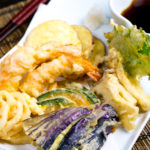
Tempura
Learn how to make perfect Tempura at home with this easy-to-follow recipe. You‘ll find plenty of helpful tips and tricks for making the crispy deep-fried batter and delicious dipping sauce. Consider this your ultimate tempura-making guide!
Servings: 2
Calories: 308kcal
Ingredients
For the Dipping Sauce (Tentsuyu)
- ¾ cup dashi (Japanese soup stock) (use standard Awase Dashi, dashi packet or powder, or Vegan Dashi)
- 3 Tbsp soy sauce
- 2 Tbsp mirin
- 2 tsp sugar
For the Tempura
- 4 shrimp (peeled and deveined, leaving on the tail and last shell segment)
- 2 king oyster mushrooms (eringi)
- 4 slices lotus root (renkon) (peeled and precooked; I used boiled lotus root (renkon no mizuni) from a Japanese grocery store)
- 4 slices Japanese sweet potato (Satsumaimo) (unpeeled)
- 4 slices kabocha squash (unpeeled)
- 1 Japanese or Chinese eggplant
- 2 shiso leaves (perilla/ooba)
For the Batter
- 1 large egg (50 g each w/o shell) (chilled)
- 200 ml iced water (¾ cup + 4 tsp)
- 1 cup all-purpose flour (plain flour) (chilled; please weigh your flour; click the Metric button for weights; or learn how to measure flour with a measuring cup)
For Deep-Frying
- neutral oil (or use a 10-to-1 ratio of neutral oil to sesame oil)
- 2 Tbsp all-purpose flour (plain flour) (for dusting the shiso and shrimp)
For Serving
- 2 inches daikon radish (grated)
Instructions
- Before You Start: Gather all the ingredients. I highly encourage you to weigh your ingredients using a kitchen scale. For weights, click the Metric button above to convert the measurements to metric. If you don't have a scale, here's how to measure flour with a measuring cup: Fluff the flour with a spoon, sprinkle it into the measuring cup, and level it off. Otherwise, you may scoop more than you need.
To Make the Dipping Sauce (Tentsuyu)
- Combine ¾ cup dashi (Japanese soup stock), 3 Tbsp soy sauce, 2 Tbsp mirin, and 2 tsp sugar in a small saucepan. Bring it to a boil, then lower the heat and let it simmer until the sugar is completely dissolved. Remove from the heat and set aside. Tip: For a quick dashi, use ¾ cup (180 ml) water + 1 tsp dashi powder.
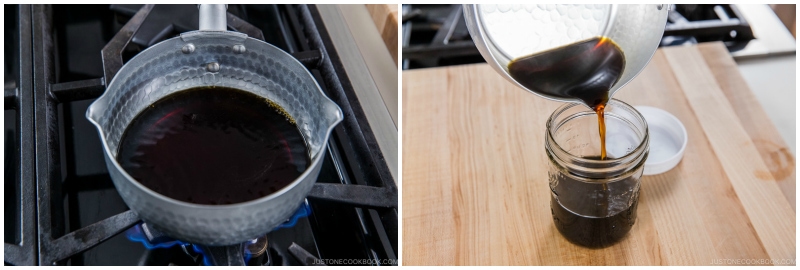
To Prepare the Ingredients
- Peel 4 shrimp, leaving on the tail and last shell segment closest to the tail. Straighten the shrimp so it looks gorgeous; learn to do this in my post How to Prepare Shrimp. Pat dry to remove the moisture completely.

- Cut 2 king oyster mushrooms (eringi), 4 slices lotus root (renkon), 4 slices Japanese sweet potato (Satsumaimo), and 4 slices kabocha squash each about ¼ inch (6 mm) thick.Set aside 1 Japanese or Chinese eggplant and prepare it immediately before you deep-fry it. When ready, cut off and discard the stem and calyx, then cut in half lengthwise. Place them flat side down on the cutting board. Leave 1 inch (2.5 cm) of the bottom tip intact so the eggplant stays attached, and cut the rest of it into thin, lengthwise slices about ⅛ inch (3 mm) thick. Gently press down to fan out the slices.
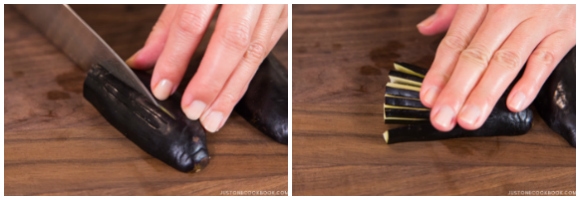
To Prepare the Oil
- In a medium-sized pot, heat 1½–2 inches (3–5 cm) of neutral oil to 350°F (180°C). Tip: For enhanced aroma and taste, I like to add 1 part sesame oil for every 10 parts neutral oil.
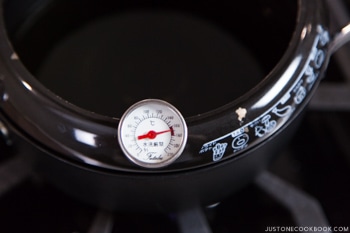
To Make the Batter
- While the oil is heating up, prepare the tempura batter. We‘ll use a 1-to-1 ratio (by volume) of flour to egg + water. First, add 1 large egg (50 g each w/o shell) and 200 ml iced water into a measuring cup or a bowl. Whisk the egg mixture vigorously. Skim off the foam on the surface and discard.
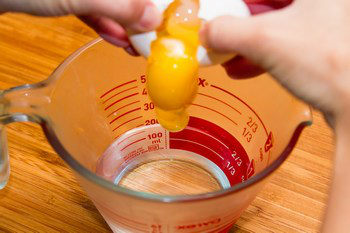
- Next, sift 1 cup all-purpose flour (plain flour) into a large bowl. Slowly pour the egg mixture into the flour and mix. Do not overmix; it’s okay to leave some lumps. Keep the batter cold at all times. I store mine in the refrigerator until ready to use. Make the batter right before deep-frying to avoid activating the wheat gluten.
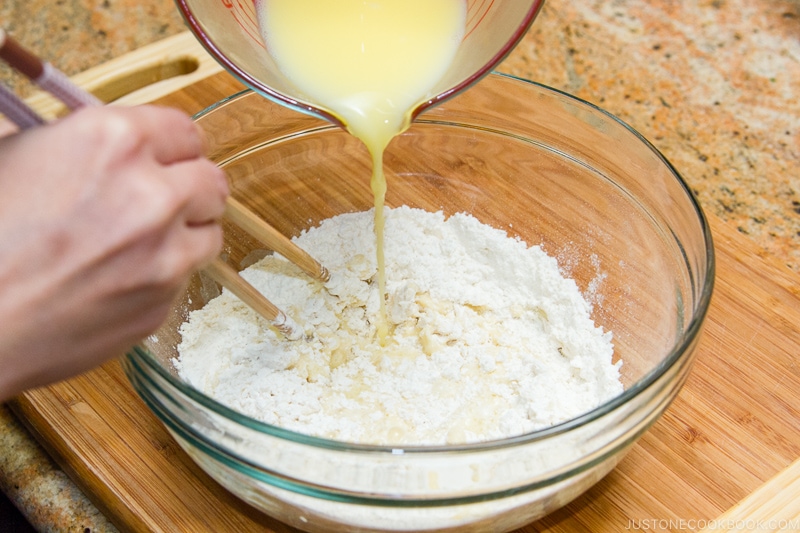
To Deep-Fry the Tempura
- Pat dry the ingredients with a paper towel, as needed. To get crispy tempura, make sure your ingredients are dry; any excess moisture will make the tempura soggy.Next, arrange the ingredients in cooking order. Start with the cleaner and less astringent ingredients. I suggest this order: Shiso, mushrooms, lotus root, eggplant, shrimp, sweet potatoes, and kabocha. We'll fry the last two ingredients at a lower oil temperature.
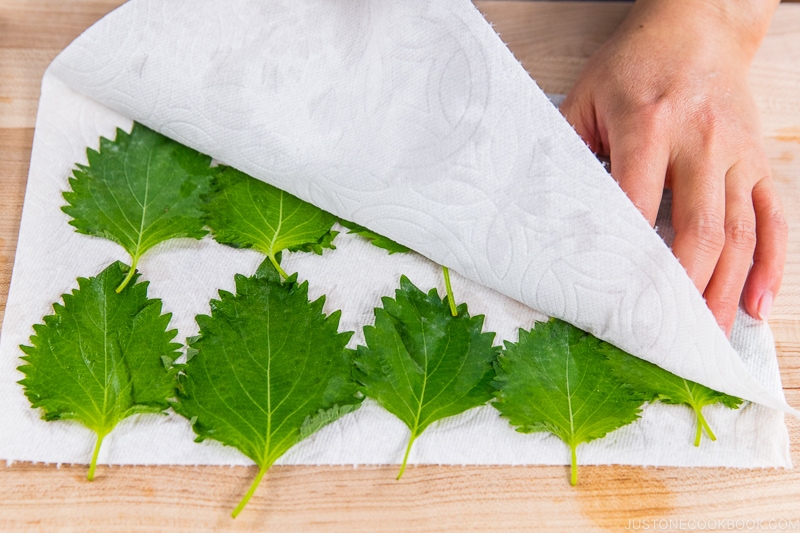
- Check that the oil temperature is 350°F (180°C) with an instant-read cooking thermometer. To check with wooden chopsticks, dip the tips in the oil; it's ready when small bubbles form around the tips. Tip: When you deep-fry, do not crowd the pot because the oil temperature will drop quickly. Try to maintain the correct oil temperature throughout cooking. For more helpful hints, read How to Deep-Fry Food.
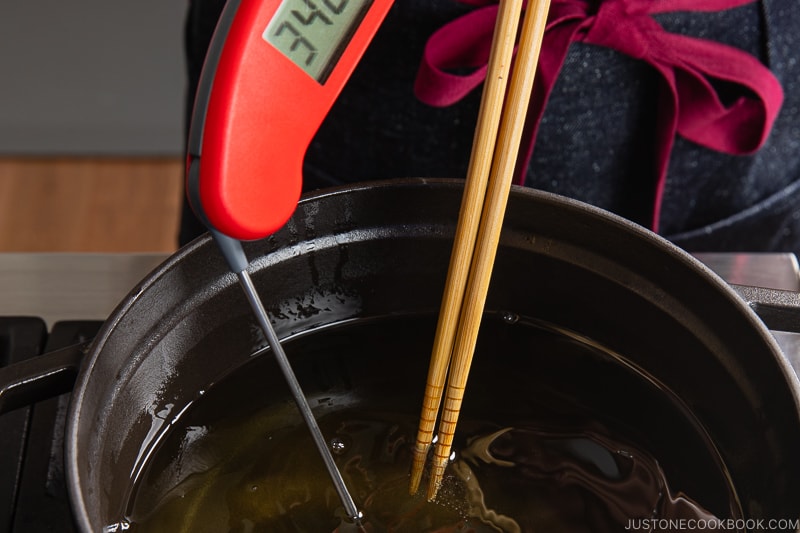
- When the oil reaches the right temperature, dip one piece of shiso, mushrooms, lotus root, eggplant, or shrimp (in this order) in the batter. Wait until later to fry the sweet potato and kabocha. For the shiso leaves, sift 2 Tbsp all-purpose flour (plain flour), sprinkle a bit on the back of the leaf, and dip only the back into the batter. The flour acts as a glue that helps the batter adhere. For the shrimp, dust lightly with the flour (or potato starch/cornstarch) before dipping. Let the excess batter drip off for 1–2 seconds, and gently place in the hot oil. Continue to dip one piece at a time and add it to the hot oil without crowding the pot. Tip: Your ingredients should take up no more than half of the oil surface area at any one time.Deep-fry until golden brown. Fry the shiso for 15–30 seconds, mushrooms for 1 minute, lotus root for 2 minutes each side, eggplant for 1 minute, and shrimp for 2 minutes.
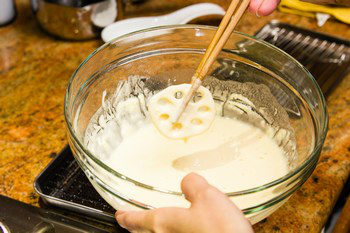
- Once golden brown, transfer the tempura to a wire rack or a plate lined with paper towels to drain the excess oil. In between batches, scoop up the crumbs (called tenkasu) in the oil using a fine-mesh skimmer. If left in the pot, the crumbs will burn and turn the oil darker.
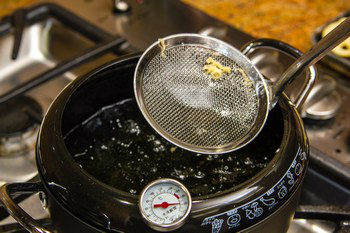
- Now, lower the oil temperature to 320ºF (160℃). Dip the sweet potatoes in the batter and cook for 3 minutes per batch. Then, dip and fry the kabocha for 2–3 minutes per batch.
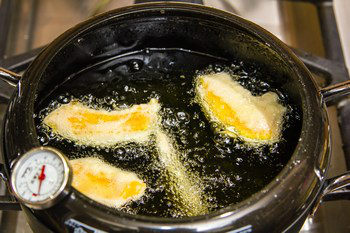
- Drain on a wire rack or a plate lined with paper towels. Repeat until you've battered and fried all the ingredients.
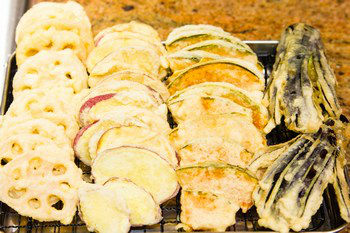
To Serve
- Peel and grate 2 inches daikon radish (I use a ceramic grater) and gently squeeze out some of the liquid. Prepare 3–4 Tbsp of warm tentsuyu in each individual dipping bowl with 1 Tbsp grated daikon per serving on the side.
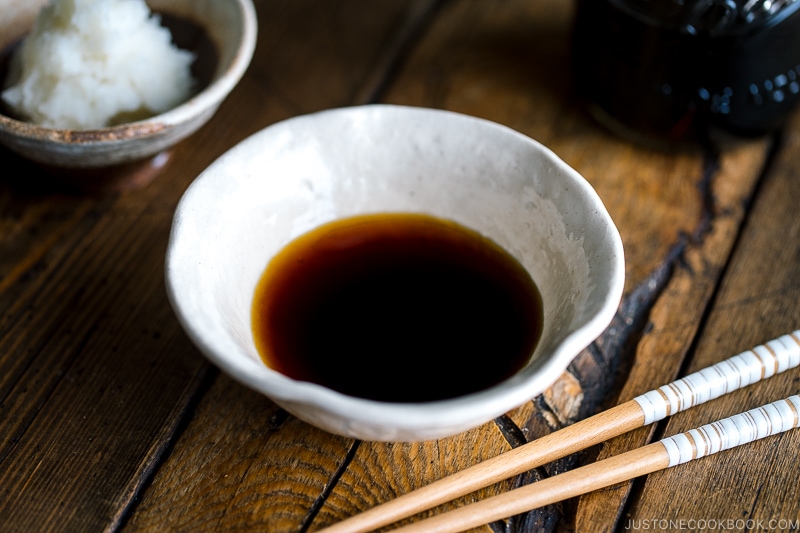
- Add the grated daikon to the dipping sauce, then dip a piece of tempura in the sauce to enjoy.
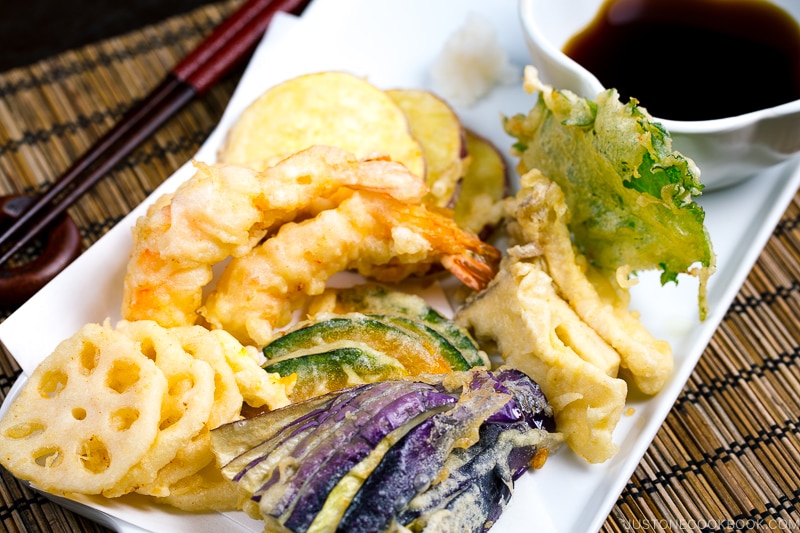
To Store
- Keep the tempura leftovers in a single layer between paper towels and put in an airtight container or a resealable plastic bag. Store in the freezer for 2 weeks. To reheat, place the tempura on a wire rack in the preheated oven (400ºF or 200ºC) or the toaster oven for 5 minutes or until crisp on the outside and heated through. If you have unused dipping sauce, you can store it in the refrigerator for up to 1–2 weeks.
Nutrition
Calories: 308 kcal · Carbohydrates: 43 g · Protein: 12 g · Fat: 10 g · Saturated Fat: 7 g · Trans Fat: 1 g · Cholesterol: 123 mg · Sodium: 473 mg · Potassium: 857 mg · Fiber: 7 g · Sugar: 8 g · Vitamin A: 7256 IU · Vitamin C: 24 mg · Calcium: 97 mg · Iron: 3 mg